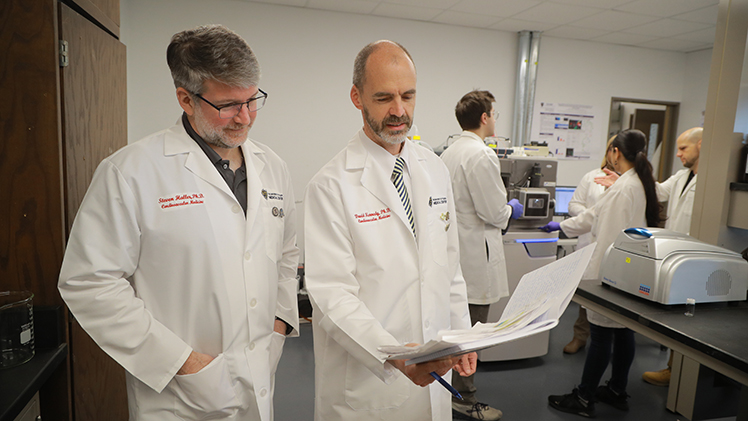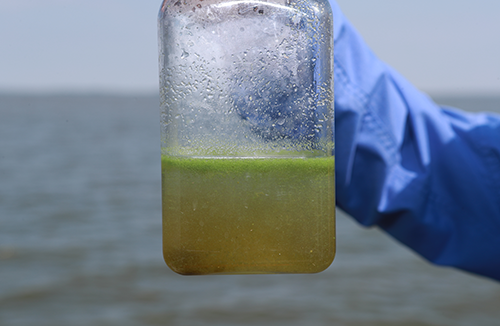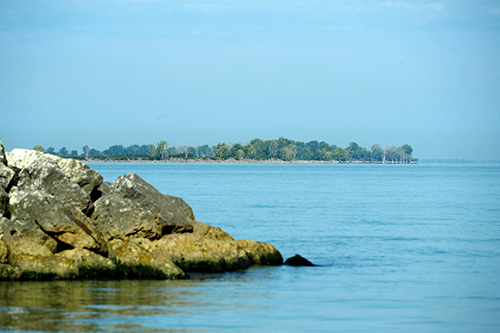The University of Toledo and the University of Michigan are partnering to lead a federally funded research center dedicated to studying harmful algal blooms in and around the Great Lakes.
Driven by climate change and pollution, large algal blooms have become a regular phenomenon across the Great Lakes, and specifically problematic in Lake Erie’s shallow western basin.

Dr. David Kennedy, left, and Dr. Steven Haller, are associate professors of medicine at UToledo. Kennedy will serve as co-director of the Great Lakes Center for Fresh Waters and Human Health and Haller will be conducting critical research into the full health effect of exposure to aerosolized toxins from the Lake Erie algal bloom.
“These algal blooms are not just a cosmetic problem. It’s not just green water,” said Dr. David Kennedy, an associate professor of medicine at UToledo. “They are a threat to the environment, a threat to the economy and a threat to human health. It is critical that we as a region step up to meet this challenge.”
Kennedy will serve as co-director of the Great Lakes Center for Fresh Waters and Human Health, which has been funded with $6.5 million from the National Institutes of Health and the National Science Foundation.
Led by the University of Michigan and UToledo, the Great Lakes Center for Fresh Waters and Human Health will include faculty researchers from nearly a dozen universities and chiefly focus on questions related to the effects of climate change on harmful algal blooms and how the cyanotoxins produced during the blooms affect human health.
The center, which was founded in 2018, was previously housed at Bowling Green State University.
“The threat to water resources in the Great Lakes — which hold about 95% of the surface fresh water in the U.S. and support a multibillion-dollar blue economy —is real,” said Dr. Gregory Dick, an environmental microbiologist at Michigan and the center’s director. “But despite these serious threats, key scientific questions surrounding the climate drivers and health impacts of cyanobacterial harmful algal blooms remain unresolved.”
Harmful algal blooms, which are caused by organisms called cyanobacteria, have been present in the Great Lakes for decades. However, several large recent blooms have captured significant public attention — including the 2014 bloom that resulted in the city of Toledo issuing a do-not-drink order for half a million northwest Ohio residents.
“This is a significant problem that requires an interdisciplinary, collaborative response,” said Dr. Frank Calzonetti, vice president for innovation and economic development at UToledo. “We have played a leadership role in studying harmful algal blooms for nearly two decades. Our scientists have stepped up to meet this challenge, and this center both recognizes that leadership and strengthens the partnerships we’ve developed.”

One of the larger questions surrounding harmful algal blooms relates to how people may be exposed to toxins.
While public health authorities have regularly closed beaches and issued warnings about coming into contact with the water during blooms, research from both UToledo and Michigan has shown cyanotoxins also can become airborne as waves crash against the shoreline.
The full health effect of exposure to those aerosolized toxins is unknown, but there is growing evidence — much of it from UToledo researchers — that suggests breathing in those toxins can cause biological changes.
Dr. Steven Haller, an associate professor of medicine at UToledo, for example, has previously shown that cells on the inside layer of the lung become inflamed when exposed to aerosolized microcystin.
“You might drink two liters of water a day. We breathe 11,000 liters of air a day,” Haller said. “You can choose to drink bottled water but you can’t choose what air you’re breathing, and what we breathe has almost immediate access to our bloodstream. This is an incredibly important area of study.”
As part of the Great Lakes Center for Fresh Waters and Human Health, UToledo will be deploying an aerosol sensor network in the western Lake Erie basin to better categorize what’s in the air during blooms.
Using that data, they’ll conduct high-tech experiments in which they expose human lung cells to the toxins present in the air and measure the response.

Research from both UToledo and Michigan has shown cyanotoxins produced by the algal blooms can become airborne as waves crash against the shoreline.
UToledo also is launching a first-of-its-kind prospective health study in which researchers will follow 200 individuals aged 10 and older who live, work or recreate within a half-mile of the lakeshore over the course of five years.
Three times a year — before, during and after the summer algal blooms — researchers will survey individuals about their health and collect biological samples including blood, urine and nasal brush biopsies.
“We suspect there will be some people who exhibit no response while others show measurable effects from the exposure,” Haller said. “If we can determine what makes people susceptible, we may be able to identify who needs to take additional precautions.”
The large library of data could also help prove out novel diagnostic tests for exposure to microcystin toxins that are under investigation now or tests that are created in the future.
Other projects at the research center will include a study of how cyanobacteria release their toxins and become airborne, research into how climate change is influencing the proliferation of harmful algal blooms and the toxins they produce, and an investigation aimed at identifying new cyanobacterial toxins within the Great Lakes.
While these projects are individually important, Kennedy said the discoveries generated from the center’s work will be larger than the sum of their parts.
“You can’t really separate the environment from human health. We need to understand how the Great Lakes are changing. What’s happening at the shore and in the air and what the impact is on the health of our community, particularly those who live near the lake?” he said. “This is a problem that has hung over our head for years as a cause of concern. These studies are our opportunity to provide answers about how this is impacting the region and what we can do about it.”